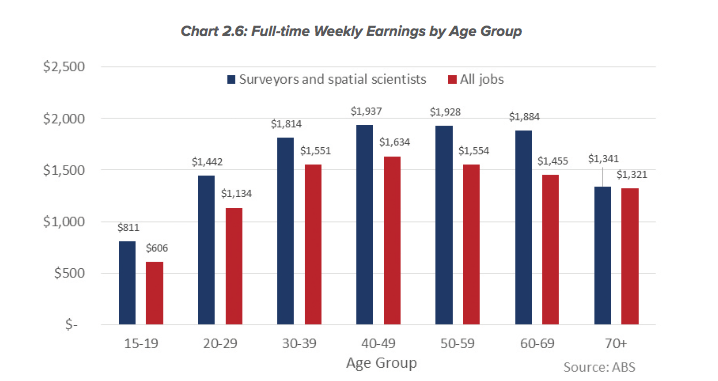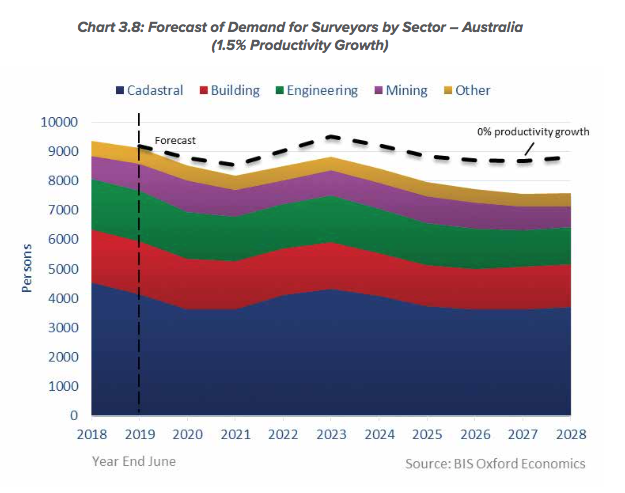Industry findings
There have been ongoing attempts to address the skills shortage in the surveying industry. In March 2019, a new report ‘Determining the Future Demand, Supply and skills Gap for Surveying and Geospatial Professionals 2018-2028’ from BIS Oxford Economics offered the most up-to-date figures on the profession for some time. It forecasts a shortage of surveyors across Australia, which means increased job opportunities for students considering a career in surveying over the next 10 years. In fact, with those job opportunities come salaries that best the national average.
Australian results
In Australia there are currently 8,172 various surveying professionals in the country – including cadastral, building, mining and engineering surveyors, as well as registered/licensed surveyors. However, there is demand for 9,125 surveyors. This means we need 953 more surveyors to meet the current labour requirements.
Of these surveying professionals, there is estimated to be a workforce gap of 297 registered/licensed surveyors. Clearly that suggests a lot of opportunities for students entering the field of surveying studies.
Whilst, due to industry demand and workplace entries, the workforce gap is forecast to narrow in upcoming years, it will fluctuate again into the future. For example, in five years’ time in 2023, there is expected to be a gap of 302 registered/licensed surveyors.
The Stats
| Year | Forecasted surveyors | Forecasted demand | Projected gap |
| 2019 | 2,543 | 2,840 | 297 |
| 2023 | 2,447 | 2,749 | 302 |
While many industries are currently suffering a drop in available jobs, this is certainly not the case for the surveying profession. Recent graduates can feel confident in finding work and enjoying a secure and lasting career.
The Australian Government has also reported that the current labour market rating for ‘surveyor’ has been classified as ‘shortage’. Vacancies are not being filled and on average there aren’t enough suitable applicants per vacancy.
In particular, New South Wales and Victoria are reporting the most significant shortages.
New South Wales
The New South Wales forecast shows a similar trend – which signals career opportunity for secondary students considering the study of surveying..
From 2019 the gap between the number of surveyors and the number of surveyors needed will fall from a staggering 819 persons to a more reasonable 115 by 2021 – only to track back up to 510 in 2023. These figures indicates a lot of opportunities for surveyors entering the industry in this state.
Victoria
It is not just New South Wales-based surveyors that can look forward to increased job security and higher starting salaries.
There is forecast to be a relatively steady shortage of surveyors in Victoria, running from 567 in 2019 through to 245 in 2021, then 411 in 2023. Secondary students who commence university studies and continue with post university training to become a licensed surveyor will be in demand by the time they have completed.
The NSW Surveyor-General’s Thoughts
Narelle Underwood, the youngest person and first woman to ever step into the role of Surveyor-General in NSW, is – like many surveyors – well-aware of the ongoing skills shortage. She hopes to see an increase in interest in the coming years and is buoyed by the enthusiasm of some of the younger people she has been speaking with.
Speaking here at the March 2019 Women In Surveying Day event, Narelle talks about the importance of exposing young people to all that surveying has to offer them – as a study path and as a profession.
The Good Education Group findings
Higher graduate salary and excellent job prospects are just two reasons surveying is a career path secondary students should take note of. According to The Good Education Group, which publishes The Good Careers Guide, surveying has the fourth highest average starting salary at $60,049 compared with the national average of $52,840.
Graduate surveyors are also among the most likely to be employed straight out of university, with the third highest employment rate at 78%.
Good Education Group data manager Ross White said science, technology, engineering and maths (STEM) graduates are in high demand because they have specialised and transferable skills and there are less people entering these fields.
If you’re science, maths, engineering or technology inclined, consider a career where you will have an impact on the world while enjoying great pay and job opportunities.
Source: STEM graduates earn more money and are more likely to land a job, news.com.au
View the Report
To read a copy of the BIS Oxford Economics report on behalf of ACS National, please fill out the following form.



